Friday, November 30, 2007
Wednesday, November 21, 2007
Animalpedia: Harlequin bugs
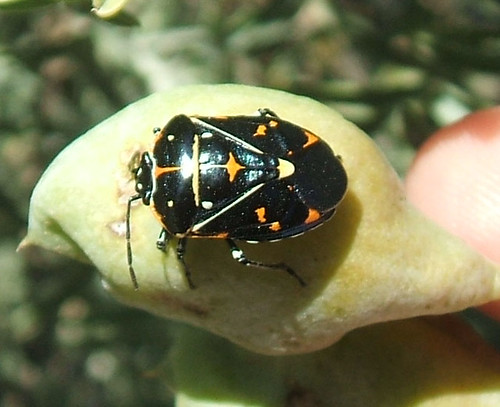
These are Harlequin bugs, or Harlequin cabbage beetles (Murgantia histrionica). They live by sucking the juices out of cabbages and other cabbage family members. Most of the time they are considered a pest by farmers. They are part of the stinkbug family, although they also play dead when disturbed.
The females lay up to 12 eggs in a double line on the leaves…

After hatching, the young (nymphs) cannot fly. They will go through 5 successive molts before they get the color patterns and the wings of an adult. That takes approximately 42-47 days.
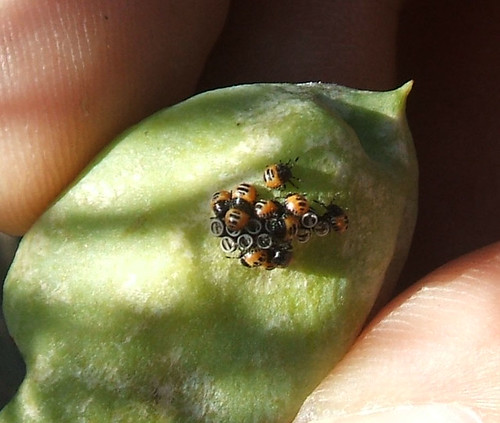 They are very dependant on temperature conditions for their growth and development.In northern areas, they only have one clutch per year. In southern areas they can have three clutches. When mating the male and female stand with their abdomens touching, for the transfer of sperm.
They are very dependant on temperature conditions for their growth and development.In northern areas, they only have one clutch per year. In southern areas they can have three clutches. When mating the male and female stand with their abdomens touching, for the transfer of sperm.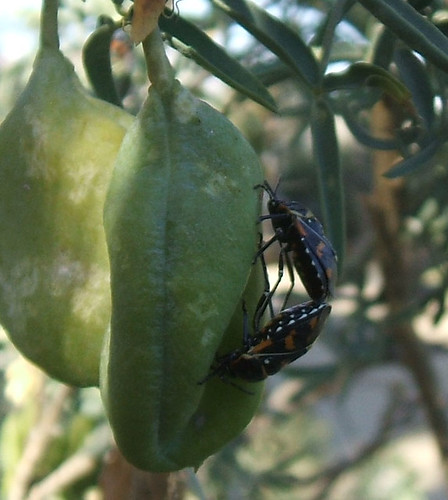
These bug pictures were all taken on one Bladderpod bush, a native bush to California. Some harlequin bugs will spend their entire lives on a single bush.
Sunday, November 18, 2007
Weekly video: Blue Pearl Bay, Australia
They say watching fish is relaxing, and boy, could I use that right now... So, a video taken from Blue Pearl Bay, also referred to as the 'fish tank'.
I want to do a post on some of the cool talks I heard at the meeting I went to last week, and I will soon. I just need to finish the results section of my thesis and get back on track with grading. That is so enjoyable. After all, "the results showed that higher temperatures did not decrease the population growth, instead slowed it down from growing".
However, in all fairness, my writing probably distresses my advisor to a similar degree!
I want to do a post on some of the cool talks I heard at the meeting I went to last week, and I will soon. I just need to finish the results section of my thesis and get back on track with grading. That is so enjoyable. After all, "the results showed that higher temperatures did not decrease the population growth, instead slowed it down from growing".
However, in all fairness, my writing probably distresses my advisor to a similar degree!
Thursday, November 8, 2007
Weekly video: Humpback whales
Always a favorite, some humpback whale playing around our boat on the way to a coral island.
Tuesday, November 6, 2007
Animalpedia: Soldier Crabs
 This is a soldier crab, most likely Mictyris longicarpus, the light blue soldier crab. They live on the sand and mudflats in Australia from Victoria to northern Queensland. They tend to come out of their temporary burrows when the tide is out to feed on organic material that they filter out of the moist sand. They seem to make a looser packed ball of sand of discarded than the sand bubbler crab.
This is a soldier crab, most likely Mictyris longicarpus, the light blue soldier crab. They live on the sand and mudflats in Australia from Victoria to northern Queensland. They tend to come out of their temporary burrows when the tide is out to feed on organic material that they filter out of the moist sand. They seem to make a looser packed ball of sand of discarded than the sand bubbler crab.Its name comes from its tendancy to form large groups (hundreds) of crabs which then march down the beach. I’ve heard tell that the larger crabs ‘direct’ the movement (i.e. smaller crabs follow them) earning them the nickname of general crabs, but I have yet to find some verification of this. When disturbed, the crabs corkscrew into the sand on their side.
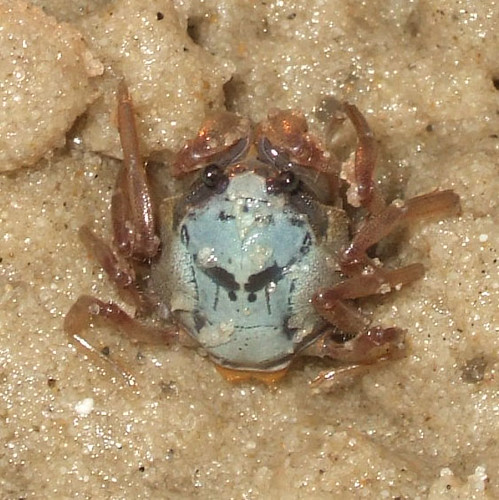
Young soldier crab
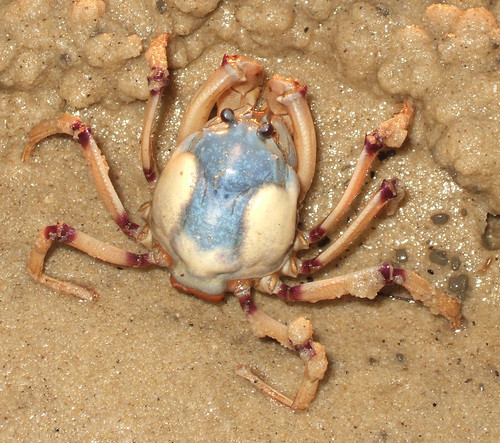
'General' soldier crab
Soldier crabs have an interesting physiology, their gill chamber is modified to work in air and water. The gill chamber is divided into two sections, one which circulateds water over gills, and the other section is a thicker lining of respitory tissue penitrated by thin tubes ending in a thin layer of tissue, much like the insect trachiole system in function (Maitland and Maitland, 1992).
Saturday, November 3, 2007
Weekly Video: 1st Division
It's my favorite lab to teach, development! Here is a video of the first division of a fertilized sand dollar embryo. It's a little choppy, I was trying to figure out how to speed it up in the new iMovie program and was only partially successful.
Thursday, November 1, 2007
Development: how big is big enough?

This picture is of a fertilized sand dollar egg. You can see the dark pigment dots and the clear circle around the egg, which is the fertilization membrane, and the light smears which are sperm still trying to get at the egg. However, the fertilization membrane prevents any other sperm from entering the egg.
I read an interesting paper about development and sea urchins. A little background: there are three different developmental modes in many different invertebrate species. One is nonfeeding, where the young develop into adults using only the energy (yolk) provided by the mother. Another is feeding where the young spend more time in the larval stage feeding and that’s where they get the energy to transform into the adult. The final mode is very rare and it is called facultative feeding. In this case the young don’t have to feed to transform, but they can to get extra energy. Unlike the nonfeeding larvae who can’t feed even if they wanted to, because they don’t have a complete digestive track.
As you can imagine egg sizes for these different mode vary. Since the nonfeeding modes rely only on what the mother supplies to get to a suitable spot and change into an adult, they tend to be very large. The feeding ones are smaller, because they only have to have enough energy to create a gut, then they can feed themselves till they become an adult. The facultative ones are in between (in general). It is thought that this mode is a very unstable one, and that the species that have it are on their way from feeding to nonfeeding modes or vice versa.
What these researchers tried to do was to take a facultative feeder and force it to become a feeder by reducing the amount of energy available to the young. They did that by taking 2-cell and 4-cell stage and breaking them apart, so that one treatment had ½ the energy and the other treatment had ¼ the energy.
2-cell stage 4-cell stage


They then raised some of each type with food and without food to see if the young with less energy were eating and growing faster than those with less energy who had no food. Of course, they found that young that had not been manipulated were larger that those that had been halved or ‘fourthed’. What was interesting was that none of the size-manipulated young were forced to feed to complete metamorphosis. All young transformed at the same time!
This means that the mothers gave up to 4 times the amount of energy needed to undergo metamorphosis to their young!
This means that the mothers gave up to 4 times the amount of energy needed to undergo metamorphosis to their young!
For more info see the original paper: Allen, J.D., C. Zakas, R.D. Podolsky. 2006. Effects of egg size reduction and larval feeding on juvenile quality for a species with faciltative-feeding development. Journal of Experimental Marine Biology and Ecology. 331:186.197
Subscribe to:
Comments (Atom)


